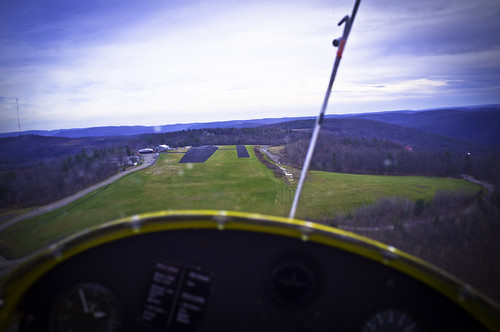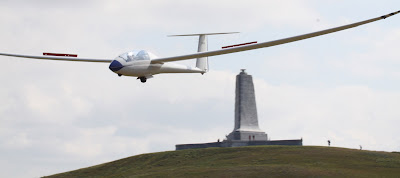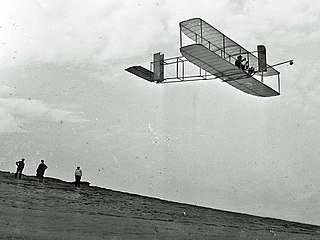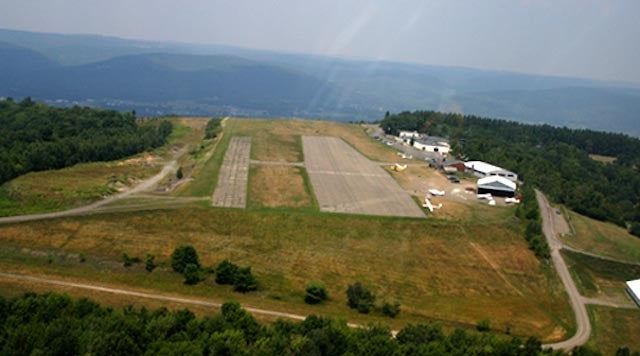This post could probably be sub-titled "How to (almost) land out without even trying."
Last Friday, in preparation for my commercial glider checkride, I decided to take the afternoon off and fly some spot landings to convince myself yet again that I know how to fly and calm my apprehensiveness.
When I got to Harris Hill, the place was a beehive of activity. The soaring forecast was not just good, it was GREAT. One of our members remarked that it was the best soaring day of the season. I grabbed the last ASK-21 available, put a battery in it so I could monitor what everyone else was doing and took off.
I could hear that most of my fellow pilots were up between 7,000 and 8,000 and lift was everywhere. The thermals were closely spaced, nicely marked by cumulus clouds, there was little wind to tilt them over and they were reasonably strong. Buoyed by all the good reports of lift, I got off tow a few hundred feet lower than normal as we passed through a 4 knot thermal.
A 'blue hole' was over Harris Hill. This is fairly common at our field when the wind blows cool air off of Seneca lake to the Southwest. The cooler air dries up the clouds and can kill the thermals in the hole. I'd gotten off tow at the edge of the hole and circled up to about 4,500 when the thermal petered out. I decided to move away from the hole to the southwest where some cumulus clouds looked promising.
I kept finding lift, but only of the 2 knot variety. I was able to stay at about 4,500 feet but couldn't seem to connect with thermals that would take you to 7 and 8,000 feet where everyone else was. I continued to move from cloud to cloud trying to find better lift to get higher.
Eventually, I wasn't even finding 2 knot lift. At 3,900 feet I thought I'd try one more cloud before turning back to the airport as I was getting pretty far away. That cloud didn't work out and I turned back to the airport. It looked pretty far away and I considered that the little itch in my head that told me to go back at the last cloud would have been a really good idea.
As I headed back, I saw why the thermals were dying. The blue hole had shifted to the Southwest -my direction, and was killing the lift. I would have to cross the blue hole to get back to Harris Hill.
At this point, aside from being deeply disappointed with allowing myself to get this low this far away from the airport, I considered my options. I could head North and get out over the Chemung valley and probably land out in a field down there. I could head West, even farther away and look for more thermals. There were lots of fields to land in, if necessary. Or, I could head back to Harris Hill and most likely land somewhere in between.
Looking back towards Harris Hill, I could see at least 5 fields that were grass covered and easy to land in. I figured I'd head back, not expecting to find any lift, and likely land in one of those fields. If I was lucky, I could make it to the valley and easily glide to our emergency landing field in the valley.
I headed back and, as I expected, didn't find lift. However, there were periods of zero sink. I slowed up during those times and sped up to best L/D speed when I wasn't in it. Fortunately, there wasn't a lot of sink. I eventually found a small 2 knot thermal. I circled tightly, perhaps 50 degrees of bank (great practice for my upcoming flight check!) and managed to gain a few hundred feet. But it wasn't a very high thermal and I still didn't have enough to get back to Harris Hill. Reluctantly, I left it as it died and headed East again.
Fortunately, that thermal gave me the altitude I needed to get to the monastery which is on the edge of the hill overlooking the valley with our emergency landing field and, although I was too low to get to Harris Hill, I knew I could glide to the field, or if things were not going well, I could land in the field in the monastery.
As I passed over the chapel, I caught some lift near the edge of the dropoff to the valley. I was perhaps 500 feet above the high ground and did a circle. The thermal was small and I banked over, determined not to lose contact with this one and managed to gain a few hundred feet. While circling, I heard someone on the radio remarking that one of our gliders (me) was way low and asking who it was. All this time, everyone else had been up at 8,000 feet while I was struggling for altitude!
Remembering Kai's guide to off field landings, I turned the radio off. It was distracting and I needed all the concentration I could muster. After a few minutes, I'd climbed to 2,700 feet but the thermal dissipated and I was left with 3-400 fpm of sink. It was time to cross the valley and land out.
I expected no lift over the valley -usually that is the case as the cooler air and crop cover tends to make the valley and unusual place to find lift. However, the day was warm and you never know, so I headed across the valley towards the hang glider jumpoff on the Harris Hill ridge. Still too low to make the field, I had at least accomplished making the emergency field.
I lost less altitude then I expected crossing the valley due to mostly zero sink and I arrived at our ridge with 2,100 feet of altitude. I had enough to check the knob where the hang gliders launch and while there was a burble of lift, it wasn't something you could circle in. I sighed and went through my pre-landing checklist, extending the spoilers to check them. I sidle along the ridge, still above it in zero sink when it happened.
Whoosh! I stumbled into a 2 knot thermal. I immediately circled and gained 50 feet. Continuing, I managed to center the lift and get 2 knots steady all the way around the circle. Pretty soon, I saw 2,300 feet on the altimeter, then 2,400, then the magic 2,500 which is our normal approach to landing altitude! I was now in easy gliding distance of the airport and just like that, I was NOT going to land out!
I decided I'd had enough drama and excitement for the day and left the thermal and headed in the direction of our landing pattern. Would you know it? I stumbled into a 4 knot thermal. I couldn't pass it up, so I circled and the thermal strengthened to 6 knots. In a matter of minutes I was passing through 4,000 feet and climbing. The thermal was getting wider and smoother, settling down to a steady 4 knots and I rode it all the way up to 5,000 then 6,000, then 7,000 then 8,000 feet! I topped out at 8,200 feet -FINALLY up at altitude with the rest of the gang.
I continued the flight for another 2-1/2 hours, never getting lower than 7,500 feet, finally landing with 3 hours and 19 minutes on the clock, the longest flight for me so far and the highest I've ever gone - 8,400 feet.
After I landed, I considered what I had learned.
1. I learned that I was able to formulate and execute a plan when I needed to. I knew I was pretty far away from Harris Hill and the main mistake I made was leaving a perfectly good thermal to try and find a better one, all the while moving a little farther away. There's nothing really wrong with that and there wouldn't have been anything wrong with landing out, but to be safe, I should have made a *conscious* decision to turn back or try another cloud with the possibility of landing out.
2. I did not compromise the safety of flight. There are plenty of options for landing in fields in the area I was in, so the safety of the flight was not in question. However, I will revise my aeronautical decision making to highlight when I am making a decision that includes the possibility of not returning to the field. I want that to be a very specific 'go/no-go' decision. In this case, I made it more casually than I should have because I believed the lift on this day was good (which it was) and would continue (which it eventually did).
3. I saved the flight because I was lucky, not skilled. Let's be perfectly frank - I didn't land out because I got lucky.
4. I capitalized on opportunities in a safe manner. I made good safety decisions when faced with the prospect of landing out. When I stopped to circle in lift, I made sure I had a plan if it turned into sink. I put myself in a position to take advantage of the lift when it showed up and I thermalled the glider like never before to center the lift and climb away when I needed to.
This was my best soaring flight ever. I had lows and I had highs. I probably learned more about soaring from this one flight than any books could have ever taught me. That's what I love about soaring - it's a continuous challenge and you can always do better.
 Today, Bryan and Caitlyn Reigal, Kevin and I stripped the fabric from number 3. Dave Welles stopped by to help and Ed Funk got us started but was feeling poorly and had to head home.
Today, Bryan and Caitlyn Reigal, Kevin and I stripped the fabric from number 3. Dave Welles stopped by to help and Ed Funk got us started but was feeling poorly and had to head home.
 At this point, the fuselage looks pretty bare and is ready for K&L soaring to come take a look at it and let us know how much the glass bead blasting and restoration of the frame will cost. I haven't noticed much obvious rust or pitting on the frame, so I'm hoping that its years in the hangar have helped to extend #3's life quite a bit.
At this point, the fuselage looks pretty bare and is ready for K&L soaring to come take a look at it and let us know how much the glass bead blasting and restoration of the frame will cost. I haven't noticed much obvious rust or pitting on the frame, so I'm hoping that its years in the hangar have helped to extend #3's life quite a bit.

































